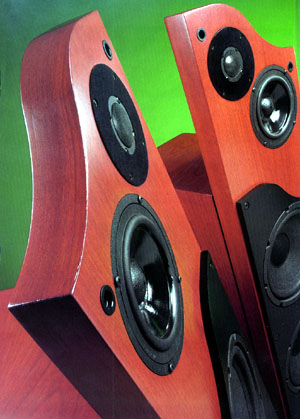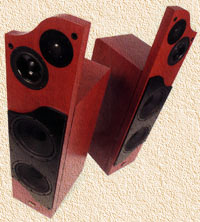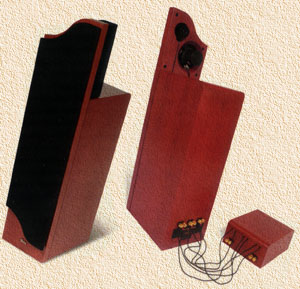
March 2004, Issue 29
EQUIPMENT REVIEW
Alón Lotus Elite Signature Loudspeaker
by Roy Gregory

Alón Lotus Elite Signature Loudspeaker
by Roy Gregory
 Back in issue 25, I reviewed the Lotus Elite, an unusual speaker from
US company Alón. This follow-up covers the Signature version of
that speaker and should be considered Part II of that original
piece. Highly regarded in their home market, the Alóns have
only been sporadically available in the UK, which is a shame, because
of all the US speakers I've listened to, the Alóns are arguably
the closest to traditional UK virtues. Most of the media attention has
tended to settle on their extravagant flagship models like the
Phalanx, but the Lotus series are in many respects just as interesting
and far more approachable. The Elite that I reviewed was the middle
one in a range of three models that, rather like the Living Voice
Auditorium / Avatar / OBX, are outwardly virtually
indistinguishable. The Signature under consideration here is the next
one up, and just like the OBX, it features an external crossover and
upgraded drivers.
Back in issue 25, I reviewed the Lotus Elite, an unusual speaker from
US company Alón. This follow-up covers the Signature version of
that speaker and should be considered Part II of that original
piece. Highly regarded in their home market, the Alóns have
only been sporadically available in the UK, which is a shame, because
of all the US speakers I've listened to, the Alóns are arguably
the closest to traditional UK virtues. Most of the media attention has
tended to settle on their extravagant flagship models like the
Phalanx, but the Lotus series are in many respects just as interesting
and far more approachable. The Elite that I reviewed was the middle
one in a range of three models that, rather like the Living Voice
Auditorium / Avatar / OBX, are outwardly virtually
indistinguishable. The Signature under consideration here is the next
one up, and just like the OBX, it features an external crossover and
upgraded drivers.Having said that, the Alón speakers are certainly distinctive and definitely plough their own technological furrow. I'll refer you to that earlier review for the full technical lowdown, but here's the potted version. The Lotus Elite speakers employ four drive-units in a three-way configuration (although the basic Esprit model has only a single bass driver). The twin bass units each enjoy a separate sealed enclosure, each volume being different. Alón's claims that this delivers a more linear bass performance certainly seem to be borne out in practice. The mid and treble drivers are mounted open baffle and in the case of the Elite Signature, all the drive units employ AlNiCo magnets - good for linearity, not so good for efficiency or motor power. Take a look at the caps on the rear of the exposed mid and treble units and you'll notice their serious depth - an attempt to compensate for the relatively low magnetic power of AlNiCo with sheer material quantity. It has to be considered successful as the Signature gives nothing away in terms of efficiency to the conventionally driven tweeters and bass units on the Elite, although neither scores particularly high marks in this regard. However the Signature does claim an extra 7Hz of bandwidth, with a -3dB point of 28Hz, which is pretty astonishing given the modest overall dimensions of the cabinet.
 The separate crossovers are built into small, veneered enclosures,
shaped and finished to match the speakers. They carry three sets of
flying leads to link to the terminals on the back of the main cabinet,
and are supported on the same blunt spikes that are used to angle and
stabilise the speakers. Bi-wire input terminals are provided. However
those flying leads must be considered something of a mixed
blessing. On the one hand, they save the owner the cost of extra short
speaker cables to hook the crossovers to the main cabinets. But on the
other they make it almost impossible to use the same cable all the way
from amplifier output to speaker input - a critical consideration if
experience with the OBX is anything to go by.
The separate crossovers are built into small, veneered enclosures,
shaped and finished to match the speakers. They carry three sets of
flying leads to link to the terminals on the back of the main cabinet,
and are supported on the same blunt spikes that are used to angle and
stabilise the speakers. Bi-wire input terminals are provided. However
those flying leads must be considered something of a mixed
blessing. On the one hand, they save the owner the cost of extra short
speaker cables to hook the crossovers to the main cabinets. But on the
other they make it almost impossible to use the same cable all the way
from amplifier output to speaker input - a critical consideration if
experience with the OBX is anything to go by.
So much for the material content, can the performance of the Signature justify nearly doubling the price of the Elite? Even a cursory listen reveals that the Signature has diluted none of the standard Elite's virtues, always a risk when you try to build on an established success. The seamless coherence, scale and easy intimacy that made the more modest version so enticing are all present and correct. Indeed, the imaging will come as your first major surprise if you haven't heard the Alóns before. It's those open baffle drivers don't you know? But along with the dipolar style and dimensions of the soundstage, the other thing you get is the absence of box colouration and it's here that the differences between the Elite and the Signature really begin.
 So let's start at the bottom and those extra 7Hz. Now I have no way to
reliably verify that claim save to say that the quality of the bass
extension from the Signature is quite distinct from my memories of the
Elite. I'd say it goes deeper but also that it's lighter and more
subtle, with a defter rhythmic touch. Bass hues are easier to follow
and the notes are more precisely timed, albeit at the expense of a
little weight. But it's the absence of that weight that is so critical
to the sound of the speaker as a whole. The open baffle may leave the
midrange refreshingly free of boxy effects, but if you want to make
the most of extending the AlNiCo magnets across the entire drive unit
complement then you need to prevent the cabinet from obscuring the
benefits. The lighter touch of the Signature's bottom end is deeper
and more linear bringing clarity and timbral definition to the entire
musical range exactly what you need if you want to hear the
theoretical improvements in tonal balance and accuracy.
So let's start at the bottom and those extra 7Hz. Now I have no way to
reliably verify that claim save to say that the quality of the bass
extension from the Signature is quite distinct from my memories of the
Elite. I'd say it goes deeper but also that it's lighter and more
subtle, with a defter rhythmic touch. Bass hues are easier to follow
and the notes are more precisely timed, albeit at the expense of a
little weight. But it's the absence of that weight that is so critical
to the sound of the speaker as a whole. The open baffle may leave the
midrange refreshingly free of boxy effects, but if you want to make
the most of extending the AlNiCo magnets across the entire drive unit
complement then you need to prevent the cabinet from obscuring the
benefits. The lighter touch of the Signature's bottom end is deeper
and more linear bringing clarity and timbral definition to the entire
musical range exactly what you need if you want to hear the
theoretical improvements in tonal balance and accuracy.
And it works too. Whether what you're getting is the result of isolating the crossover from mechanical interference, or the superiority of the AlNiCo motors, there's more low-level information, more texture and more instrumental colour on offer from the Signatures. Playing 'Poortoun' from Jackie Leven's Fairy Tales For Hard Men it's not just the expansive dimensions of the acoustic space that impress but the transparency and atmosphere that goes with them. Sat front and centre, Jackie's characteristic voice is unmistakable, as is the way he works and accents it. The varying weight and attack of the plucked guitar notes adds to the expressive melancholy of the track; the spacious, subtle underpinning of the keyboards helps it swell and flow. But listen further into the mix and you can hear the length of the guitar's fretboard and the length of its strings.
The myriad instrumental voices that make up the wash of sound that opens Debussy's Images For Orchestra (Munch/BSO RCA LSC-2282) are totally distinct, the shifts in pace and density natural and without strain. The orchestra is a stable entity locked in its impressively dimensioned acoustic, wandering neither with time nor level. Nor does the Signature suffer to anything like the same extent as the Elite when it comes to the issue of listening threshold. It's far happier (and more convincing) when playing at lower volumes, although it too accepts power with grace and confidence. The slight metallic sheen that could infect the Elite's high frequencies is also all but gone, arguably at the expense of some bite although this could be an effect of lower overall distortion reducing energy or the increase in low-end reach. Either way the Elite seemingly had a shade less air but more sparkle. But the upside is that the same easy natural tonality now extends across the entire range, delivering even greater overall coherence.
The wide open presentation and tonal sophistication of the Lotus Elite Signature make it a natural choice for all kinds of acoustic music, be it solo voice and guitar, a small jazz band or the classical repertoire. Meanwhile, its grace under fire and sense of scale make it equal to the demands of all but the most excessive orchestral works (and there are always sub-woofers for those). Opera of course is spectacular. The real question is how to get the best out of it and who's going to appreciate the benefits. Their lowish efficiency makes them less than ideal with really low powered amps, despite the designer's protestations to the contrary. They really come into their own with an amp that combines subtlety and power The conrad-johnson MV60 would be a good starting point, the Premier 140 or Hovland BADIA even better. But in the same way that the speaker has had to be careful to preserve its fragile benefits, you'll have to exercise equal care in system matching. The Signature can offer convincing performance advantages over the standard Elite, but they are easy to mask or bypass. The system needs to be right and so do the recordings to make the upgrade worthwhile: What price subtlety?
TECHNICAL SPECIFICATIONS
Type: Three-way loudspeaker with open baffle mid and treble drivers and separate crossovers.
Drive units:
25mm aluminium dome with AlNiCo magnet
130mm tri-laminate cone with AlNiCo magnet
2x 200mw pulp cone with AlNiCo magnets
Efficiency: 89 dB (estimated)
Bandwidth: -3dB at 27Hz
Impedance: 8 Ohms nominal, 4 Ohms minimum
Dimensions (WxHxD): 255 x 1030 x 380mm
Weight: 35kg
Finishes: Cherry or black ash
Price: £8000
UK Distributor:
Alón UK Ltd.
Tel. (44)(0)20 7684 1490
E-mail. pammusic@bushinternet.com
Manufacturer:
Alón Ltd.
Net. www.alonbyacarian.com